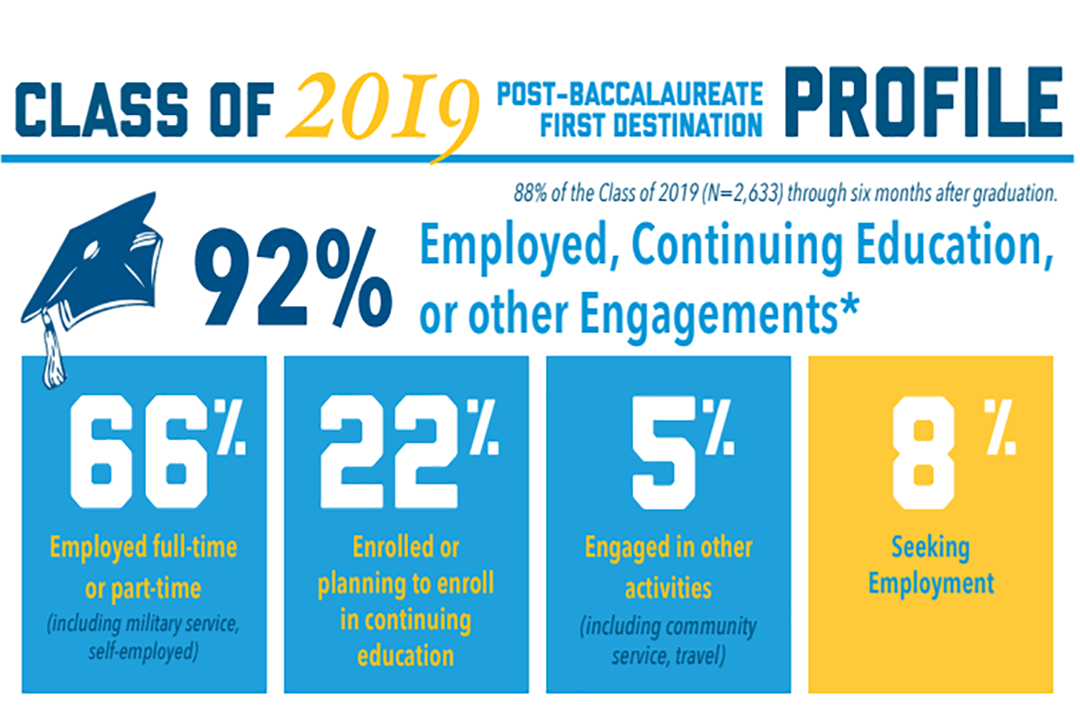By Briahnna Brown
About nine out of 10 graduates in the George Washington University class of 2019 have solidified employment, education or community service plans within six months of graduation, the annual First Destination survey reports.
The post-baccalaureate First Destination survey, which the Center for Career Services and the Office of Survey Research and Analysis conduct, explores undergraduate employment and education outcomes six months after graduation.
The data will be added to the Undergraduate Employment and Education Outcomes data visualization that helps current and prospective GW students by providing a broad look at where a GW degree in various fields of study can take them based on where alumni have gone.
Of the 2,633 survey respondents—which totaled 88 percent of the class of 2019—66 percent indicated that they secured full-time or part-time employment, 22 percent were enrolled or planned to enroll in continuing education, and 5 percent are engaged in other activities such as community service or travel.
Hana Kim, B.A. ’19, said that her time at GW afforded her numerous opportunities to create connections with peers, professors and the university’s alumni network. She now works as a management consultant at Capco, and said the GW community encouraged her to go beyond what she thought she was capable of.
“My classes within the Elliott School also gave me the foundation and knowledge to think outside the box, question ideas and immerse myself in a wide range of subject matters,” Ms. Kim said. “The support network at Career Services is spectacular, and the amount of attention given to every student is so incredibly helpful and a big reason as to how I landed my first job.”
Of graduates seeking to continue their education, 67 percent are pursuing a master’s degree, 19 percent a law degree, 6 percent a medical degree and 7 percent a doctoral degree. Among graduates who are employed full time, 64 percent work in the private, for profit sector, 28 percent work in the nonprofit sector and 8 percent work in the public, government sector.
Most graduates (81 percent) work in the Mid-Atlantic region of the United States and a total of 8 percent are in the West/Southwest/Mountain region. Four percent are in New England, 3 percent in the Midwest, 3 percent in the Southeast and 1 percent International.
Pieter Zwart, B.A. ’19, said his coursework at GW allowed him to engage with his interests in economics and international affairs and prepared him for his work as an analyst with Concentric Energy Advisors. His advice for 2020 graduates is to identify an area of personal interest and make that the focus of post-graduate goals.
“As GW students, we are generally well-prepared for life after college,” Mr. Zwart said. “Take advantage of that leg up by seeking out meaningful opportunities that help you continue to learn and contribute to a field you find personally fulfilling.”
A high number of students continue to participate in the survey, which helps the Center for Career Services gather more data to better understand hiring trends, said Michael McKenzie, managing director for career learning and experience. There is also an upward trend in salaries, which Mr. McKenzie said indicates the competitiveness of a GW degree in the job market, as well as the job-offer resources and negotiation guidance provided by the career team.
He attributes the thorough data from this survey to Career Service’s outreach strategy that informed 2019 graduates about resources and services still available to them as alumni. They also followed up with those students who said that they had not yet secured their post-graduation plans.
“Our outreach campaign helped us confirm that many students were working or continuing their education, and it allowed us to provide extra support for the small number of alumni who were still looking,” Mr. McKenzie said. “We plan to continue these efforts for the class of 2020 with some additional outreach and support from alumni, especially for students who are searching after graduation.”


